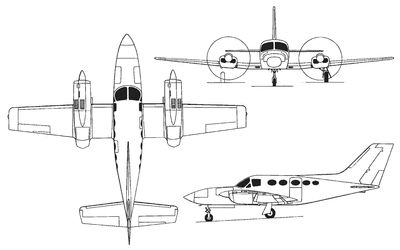Refueling Records Show Wrong Fuel Pumped Into The Airplanes' Tanks
The NTSB's investigation into an accident involving a Cessna 421C airplane flying a medical transport mission has found that the wrong fuel had been pumped into the airplane. Five people were fatally injured in the accident near Las Cruces International Airport in New Mexico.

The NTSB's post-accident review of refueling records and interviews with line service technicians showed that the airplane had been misfuelled with 40 gallons of Jet A fuel instead of the required 100LL aviation gasoline.
In its preliminary report, the NTSB Indicates that at on August 27, 2014, about 1900 mountain daylight time, the 421C, multi-engine airplane, N51RX, was destroyed after impacting terrain during initial climb near Las Cruces International Airport (LRU), Las Cruces, New Mexico. The pilot, two medical crewmembers and one patient were fatally injured. The airplane was registered to Elite Medical Air Transport, LLC; El Paso, Texas, and was operated by Amigos Aviation, Inc.; Harlingen, Texas. Day visual meteorological conditions (VMC) prevailed at the time of the accident and an instrument flight rules (IFR) flight plan had been filed for the 14 Code of Federal Regulations Part 135 air ambulance flight. At the time of the accident the airplane was departing LRU for a flight to Phoenix Sky Harbor International Airport (PHX), Phoenix, Arizona.
The airplane arrived LRU about 1834 to pick up a patient for a flight to PHX. The pilot was still seated in the cockpit when he gave the line service technician a verbal order for a total of forty gallons of fuel. The line service technician drove the fuel truck to the front of the airplane and refueled the airplane putting 20 gallons in each wing. The pilot then assisted the line service technician with replacing both fuel caps. They both walked into the office and the pilot signed the machine printed fuel ticket.

After departing LRU to the west a medical crewmember onboard the airplane called their medical dispatcher on a satellite telephone and reported they were returning to LRU because of a problem with smoke coming from the right engine. A witness driving westbound on the interstate highway reported the airplane was westbound and about 200 feet above ground level (agl) when he saw smoke begin to appear from the right engine. The airplane then began descending and started a left turn to the east. Another witness, driving eastbound on the interstate highway, reported the airplane was trailing smoke when it passed over him about 100 feet agl. He saw the descending airplane continue its left turn to the east and then lost sight of it. Several witnesses reported seeing the impact or hearing the sound of impact and they then immediately saw smoke or flames.
Evidence at the scene showed the airplane was generally eastbound and upright when it impacted terrain resulting in the separation of the left propeller and the separation of the right aileron. The airplane came to rest inverted about 100 feet from the initial impact point, and there was an immediate post-impact fire which consumed much of the airplane. Investigators who arrived at the scene on the day following the accident reported detecting the smell of jet fuel.
 Unfortunate... ANN/SportPlane Resource Guide Adds To Cautionary Advisories
Unfortunate... ANN/SportPlane Resource Guide Adds To Cautionary Advisories ANN FAQ: Turn On Post Notifications
ANN FAQ: Turn On Post Notifications ANN's Daily Aero-Term (04.29.24): Visual Approach Slope Indicator (VASI)
ANN's Daily Aero-Term (04.29.24): Visual Approach Slope Indicator (VASI) ANN's Daily Aero-Term (04.28.24): Airport Marking Aids
ANN's Daily Aero-Term (04.28.24): Airport Marking Aids ANN's Daily Aero-Linx (04.28.24)
ANN's Daily Aero-Linx (04.28.24)




